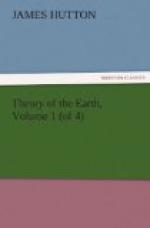“Ce fut donc cette espece de montagne qui me persuada la premiere que toutes les montagnes n’avoient pas une meme origine. Le lieu ou j’abjurai mon erreur, etoit un de ces grands chantiers petrifies, qui, par la variete du tortillement, et des zig-zags des fibres du moellon qui le composoit, attira singulierement mon attention. C’etoit un sort grand talus qui venoit d’une face escarpee; j’y montai pour m’approcher du rocher, et je remarquai, avec etonnement, des multitudes de paquets enchevetres les uns dans les autres, sans ordre ni direction fixe; les uns presqu’en rouleaux; les autres en zig-zag; et meme ce qui, separe de la montagne, eut peu etre pris pour des couches, le trouvoit incline de toute maniere dans cette meme face de rocher. Non, me dis-je alors a moi-meme; non, l’eau n’a pu faire cette montagne.... Ni celle-la donc, ajoutai-je en regardant ailleurs.... Et pourquoi mieux celle-la? Pourquoi toutes les montagnes devroient-elles etre le produit des eaux, seulement parce qu’il y en a quelques-unes qui annoncent cette origine? En effet, puis qu’on n’a songe aux eaux, comme cause des montagnes, que par les preuves evidentes que quelques-unes offroient de cette formation; pourquoi etendre cette consequence a toutes, s’il y en a beaucoup qui manquent de ces caracteres? C’est comme le dit Mr. d’Alembert, qu’on generalise ses premieres remarques l’instant d’apres qu’on ne remarquoit rien.”
Science is indebted to this author for giving us so clear a picture of natural appearances, and of his own reasoning upon those facts, in forming his opinion; he thus leads astray no person of sound judgment, although he may be in error. The disposition of things in the present case are such, that, reasoning from his principles, this author could not see the truth; because he had not been persuaded, that aquiform strata could have been so changed by the chemical power of fusion, and the mechanical force of bending while in a certain state of softness.
But though, in this case, the reasoning of this philosopher is to be justified, so far as he proceeded upon principles which could not lead him to the truth, his conduct is not so irreproachable in applying them to cases by which their fallacy might have been detected. This author acknowledges calcareous strata to be aquiform in their original; but, in those mountains which he has so much examined, he will find those aquiform bodies have undergone the same species of changes, which made him conclude that those schistus mountains had not been truly aquiform, as he at first had thought them. This would have led him to reason back upon his principles, and to say, If one species of strata may be thus changed in its texture, and its shape, may not another be equally so? Therefore, may not the origin of both be similar?
But least I should do injustice to this author, to whom we are indebted for many valuable observations in natural history, I shall transcribe what he has said upon the subject, being persuaded that my readers will not think this improper in me, or impertinent to the argument.




